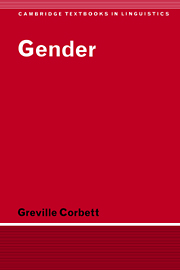Book contents
- Frontmatter
- Contents
- List of figures
- List of tables
- Preface
- List of abbreviations
- 1 INTRODUCTION
- 2 GENDER ASSIGNMENT I: SEMANTIC SYSTEMS
- 3 GENDER ASSIGNMENT II: FORMAL SYSTEMS
- 4 THE PSYCHOLINGUISTIC STATUS OF GENDER ASSIGNMENT
- 5 GENDER AGREEMENT
- 6 ESTABLISHING THE NUMBER OF GENDERS
- 7 TARGET GENDERS: SYNCRETISM AND ENFORCED GENDER FORMS
- 8 HYBRID NOUNS AND THE AGREEMENT HIERARCHY
- 9 GENDER RESOLUTION RULES
- 10 GENERALIZATIONS AND PROSPECTS
- References
- Author index
- Language index
- Subject index
3 - GENDER ASSIGNMENT II: FORMAL SYSTEMS
Published online by Cambridge University Press: 05 June 2012
- Frontmatter
- Contents
- List of figures
- List of tables
- Preface
- List of abbreviations
- 1 INTRODUCTION
- 2 GENDER ASSIGNMENT I: SEMANTIC SYSTEMS
- 3 GENDER ASSIGNMENT II: FORMAL SYSTEMS
- 4 THE PSYCHOLINGUISTIC STATUS OF GENDER ASSIGNMENT
- 5 GENDER AGREEMENT
- 6 ESTABLISHING THE NUMBER OF GENDERS
- 7 TARGET GENDERS: SYNCRETISM AND ENFORCED GENDER FORMS
- 8 HYBRID NOUNS AND THE AGREEMENT HIERARCHY
- 9 GENDER RESOLUTION RULES
- 10 GENERALIZATIONS AND PROSPECTS
- References
- Author index
- Language index
- Subject index
Summary
In the last chapter we examined languages in which gender is assigned solely by semantic criteria. We also noted languages in which semantic criteria allowed various numbers of exceptions. We now come to languages in which large numbers of nouns fall outside the semantic assignment rules. These nouns may be handled instead by formal assignment rules, that is, rules which depend on the form of the nouns involved rather than on their meaning. These rules are of two types, morphological and phonological, which we will consider in turn (sections 3.1 and 3.2). Whereas the distinction between semantic and formal assignment rules is clear (though their effects may overlap), the distinction between morphological and phonological rules is not always clear-cut. As a rule of thumb, we may say that phonological rules refer just to a single form of a noun, for example, ‘nouns ending in a vowel in the singular are feminine’. Typically, the most basic form of the noun is involved, though this is not always spelled out. Morphological rules, on the other hand, require more information; they need to refer to more than one form. This is not always obvious. A typical assignment rule of the morphological type might be: ‘nouns of declension II are feminine’; establishing that a noun is of declension II might require information about, say, the nominative singular and the genitive singular. Note that there are no syntactic systems; the obvious syntactic system would be one in which gender was assigned to nouns according to agreement.
- Type
- Chapter
- Information
- Gender , pp. 33 - 69Publisher: Cambridge University PressPrint publication year: 1991



